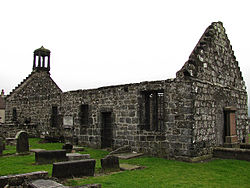| Tullibody Old Kirk | |
|---|---|
 Tullibody Old Kirk | |
| Location | Menstrie Road, Tullibody, Clackmannanshire |
| Coordinates | 56°08′13″N3°50′08″W / 56.136944°N 3.835556°W |
| Built | 12th century |
| Official name | Tullibody, old parish church |
| Designated | 18 September 1936 |
| Reference no. | SM626 |
Tullibody Old Kirk is a ruined 12th-century church in Tullibody, Clackmannanshire, Scotland. It was rebuilt in the 16th century, and restored again in 1760. The roofless building is protected as a Scheduled Ancient Monument. [1] In 1904, St Serf's Parish Church was built to the north of the Old Kirk, which was afterwards disused.
The church measures 19 by 6.7 metres (62 by 22 ft). The bellcote on the western gable dates from 1772, while the western windows and the south porch are 19th-century additions. Two doorways survive from the 16th century, including one dated 1539.
